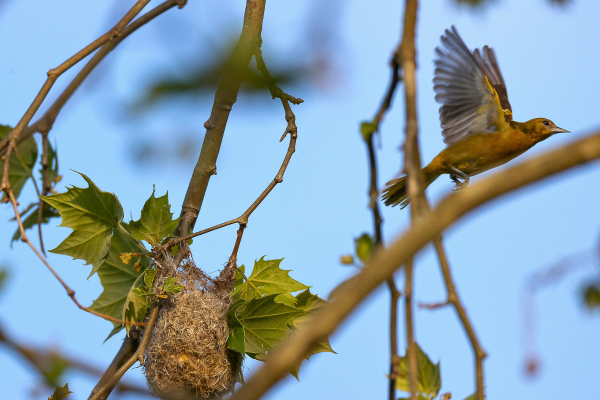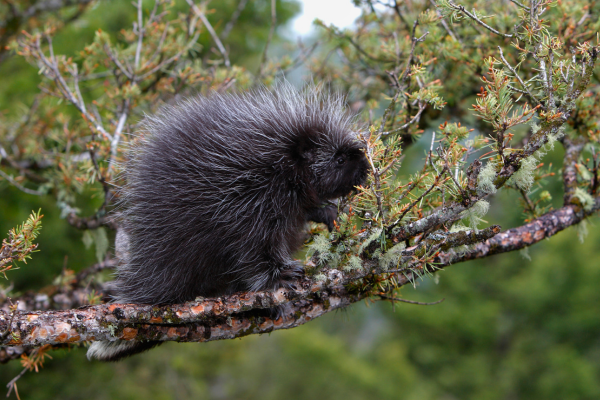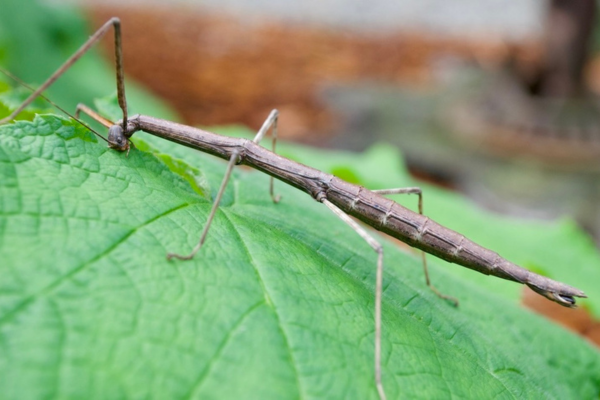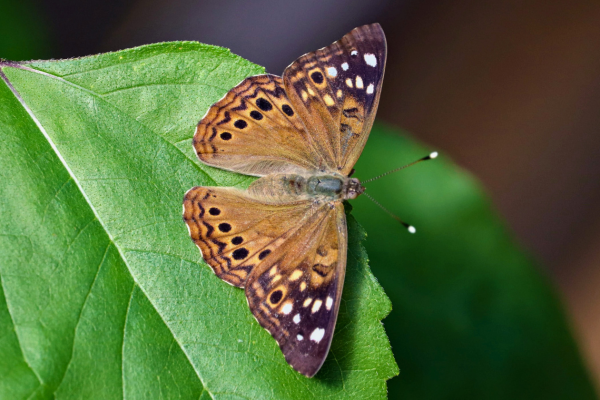Nesting in the Heights
Most birds build nests for their young, but did you know that different species choose very different locations depending on their needs? Some, like the song sparrow, place their nests low to the ground, tucking them into tall grasses or dense shrubbery where they remain hidden from predators. Others, such as the gray catbird, prefer the protection of thick shrub thickets, weaving their nests deep within the tangled branches. Meanwhile, birds like the American robin and northern cardinal opt for low-hanging tree branches, balancing concealment with a clear view of their surroundings.
But some birds prefer to stay as high up as possible, relying on the safety of the tallest branches. Red-eyed vireos tuck their cup-shaped nests into dense foliage, where they remain well hidden from ground-dwelling predators. Baltimore orioles craft intricate hanging nests that sway with the wind, suspended from the outermost branches of towering trees. Even higher, scarlet tanagers make their homes among the leafy canopies, where thick foliage offers protection and an abundance of insects to feed their young. By nesting so high, these birds take advantage of a relatively peaceful, predator-free zone, ensuring a safe space to raise their families. And towering above them all, hawks and eagles build their massive nests in the tallest trees, using their prime vantage points to survey the landscape for prey.

Mammals also make use of the upper branches. Both red squirrels and eastern grey squirrels build leafy nests, called dreys, to raise their young and take shelter from bad weather. Flying squirrels, though rarely seen due to their nocturnal habits, make their dens in tree cavities and move around by gliding effortlessly through the air from tree to tree. Raccoons often take over hollowed-out trunks but will also build leafy nests if needed. Even porcupines, who are surprisingly good climbers, spend much of their time in trees, nibbling on leaves and bark while resting among the branches.

Insects of the Treetops
Many insects are easy to spot on the ground, but a whole different community thrives in the treetops, often unnoticed. Stick insects, who are masters of disguise, blend in perfectly with twigs and leaves, making them nearly invisible to predators and people. Treehoppers, with their thorn-like appearance, perch along branches, mimicking the very plants they feed on. Small but essential, aphids and scale insects cluster on leaves and stems, serving as an important food source for birds and other predators.

Native pollinators are also busy up high. Bees and wasps collect nectar from tall-flowering trees like basswoods. Wasps, though often feared, play a crucial role in the ecosystem beyond pollination. They help control insect populations by preying on pests like aphids and caterpillars. Some wasp species, such as paper wasps and yellowjackets, even build their nests in tree branches or hollows, adding another layer of life to the canopy.
Another less obvious group of insects that call the canopy home are ants. Some ant species, often overlooked for their role in the treetops, tend to aphid colonies, nurturing them as they feed on tree sap and keeping other insects in check. These ants are vital in managing the insect population, ensuring a balanced ecosystem where every species has a role. The canopy ecosystem, in turn, supports this delicate balance, as every insect, from the tiniest aphid to the most elaborate beetle, plays a part in sustaining the life that thrives high above the ground.
Moth and Butterfly Nurseries
Ontario’s native trees serve as essential nurseries for the caterpillars of many moth and butterfly species. For instance, the Eastern tiger swallowtail butterfly relies on black cherry and tulip trees, where its caterpillars feed on the leaves before transforming into striking yellow-and-black adults. Hackberry trees host the caterpillars of the Hackberry Emperor, Tawny Emperor and American Snout butterflies. Mourning cloak caterpillars depend on elms and birches, as well as other native trees and shrubs. Among moths, the luna moth, one of the most iconic silk moths, favors black walnut and hickory trees, while the promethea silkmoth prefers tulip trees and ashes.

Often hidden among the foliage, these caterpillars play a vital role in the food web. Many fall prey to birds, small mammals and predatory insects, but those that survive go on to become important pollinators for trees, shrubs and flowering plants. Without them, the balance of the canopy ecosystem would be disrupted, underscoring the deep interconnections of life in the treetops.
From nesting birds and climbing mammals to hidden insects and essential pollinators, the canopy is an extraordinary world that supports a rich diversity of life. While we may only catch glimpses of this vibrant ecosystem from the ground, every leaf, branch and blossom plays a part in keeping our urban forests healthy. By planting and protecting Ontario’s native trees, we help sustain these hidden worlds, ensuring they continue to thrive for generations to come.
Justin Lewis is the Marketing and Communications Lead at LEAF.
The #BackyardBiodiversity campaign is a partnership initiative with the Toronto Wildlife Centre and is supported by Ontario Power Generation.
LEAF offers a subsidized Backyard Tree Planting Program for private property. The program is supported by the City of Toronto, the Regional Municipality of York, the City of Markham, the Town of Newmarket, the City of Vaughan, the Regional Municipality of Durham, the Town of Ajax, the Municipality of Clarington, the City of Oshawa, the City of Pickering, the Township of Scugog, the Town of Whitby and Ontario Power Generation.
